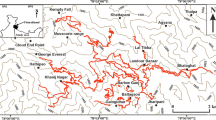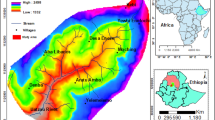Abstract
Landslides are one of the major natural disasters that occur in the Himalayan range with recurring frequency, causing enormous loss of life and property every year. Preparation of landslide inventory maps and landslide susceptibility zonation maps are the important tasks to be taken into account initially for safe mitigation measures. The present paper focuses on landslide susceptibility maps of the Ghurmi–Dhad Khola area, east Nepal, using Geographic Information System. For this purpose, the landslide susceptibility maps are prepared by using the heuristic and bivariate statistical methods. The parameters considered for the study are slope angle, slope aspect, elevation, distance from drainage, geology, land cover, rock and soil type, and distance from faults and folds. The landslide susceptibility zonation map produced from the heuristic method shows that 42.59 % of the observed landslide falls under the very high susceptible zone and 33.00 % under the high susceptible zone. Likewise, the landslide susceptibility zonation map produced from the bivariate method depicts that 44.19 % of the observed landslide falls under the very high susceptible zone and 31.59 % under the high susceptible zone. Both the landslide susceptibility zonation maps are identical, and success rates of both the maps are above 80 %. While comparing the landslide susceptibility maps obtained from two different methods, about 78 % of the study area falls in the identical susceptible zones. Special attention should be taken into consideration for the construction works in the areas which have been spatially agreed as very high and high susceptible zones from both techniques. Moreover, these maps can be used for slope management, land use planning, disaster management planning, etc., by the concerned authorities.















Similar content being viewed by others
References
Aleotti P, Chowdhury R (1999) Landslide hazard assessment: summary, review and new perspectives. Bull Eng Geol Environ 58:21–44
Anbalagan R (1992) Landslide hazard evaluation and zonation mapping in mountainous terrain. Eng Geol 32:269–277
Brabb EE (1984) Innovative approaches to landslide hazard and risk mapping. Fourth Int Symp on Landslide Can Geotech Soc Tor Can 1:307–324
Carrara A, Cardinali M, Guzzeti F, Reichenbach P (1995) GIS technology in mapping landslide hazard. In: Carrara A, Guzzetti F (eds) Geographical information systems in assessing natural hazards. Kluwer Academic Publishers, Dordrecht, The Netherlands, pp 135–175
Chung CF, Fabbri AG (1999) Probabilistic prediction models for landslide hazard mapping. Photogr Eng Remote Sens 65(12):1389–1399
Deoja BB, Dhital MR, Thapa B, Wagner A (1991) Mountain risk engineering handbook. International Centre for Integrated Mountain Development (ICIMOD), Nepal, Kathmandu, p 875
Ghosh S, van Westen CJ, Carranza EJM, Ghosal TB, Sarkar NK, Surendranath M (2009) A quantitative approach for improving the BIS (Indian) method of medium-scale landslide susceptibility. J Geol Soc India 74:625–638
Ghosh S, Günther A, Carranza EJM, van Westen CJ, Jetter VG (2010) Rock slope instability assessment using spatially distributed structural orientation data in Darjeeling Himalaya (India). Earth Surf Process Landf 35(15):1773–1792
Gorsevski PV, Gessler PE, Jankowski P (2003) Integrating a fuzzy k-means classification and a Bayesian approach for spatial prediction of landslide hazard. J Geogr Syst 5:223–251
Gupta RP, Kanungo DP, Arora MK, Sarkar S (2008) Approaches for comparative evaluation of raster GIS-based landslide susceptibility zonation maps. Int J Appl Earth Obs Geoinf 10:330–341
Guzzetti F, Carrara A, Cardinali M, Reichenbach P (1999) Landslide hazard evaluation: a review of current techniques and their application in a multi-scale study, central Italy. Geomorphology 31:181–216
Hansen A (1984) Landslide hazard analysis. In: Brunsden D, Prior DB (eds) Slope instability. Wiley, New York, pp 523–602
Hutchinson JN (1995) Keynote paper: landslide hazard assessment. In: Bell DH (ed) Landslides. Balkema, Rotterdam, pp 1805–1841
Kanungo DP, Arora MK, Sarkar S, Gupta RP (2006) A comparative study of conventional, ANN black box, fuzzy and combined neural and fuzzy weighting procedures for landslide susceptibility zonation in Darjeeling Himalayas. Eng Geol 85:347–366
Kanungo DP, Arora MK, Gupta RP, Sarkar S (2008) Landslide risk assessment using concepts of danger pixels and fuzzy set theory in Darjeeling Himalayas. Landslides 5:407–416
Kanungo DP, Arora MK, Sarkar S, Gupta RP (2009) A fuzzy set based approach for integration of thematic maps for landslide susceptibility zonation. Georisk: Assess Manage Risk Eng Syst Geohazards 3(1):30–43
Kayastha P, De Smedt F, Dhital MR (2010) GIS based landslide susceptibility assessment in Nepal Himalaya: a comparison of heuristic and statistical bivariate analysis. In: Malet JP, Glade T, Casagli N (eds) Mountain risks: bringing science to society. CERG Editions, France, pp 121–128
Nagarajan R, Roy A, Vinod Kumar R, Mukherjee A, Khire MV (2000) Landslide hazard susceptibility mapping based on terrain and climatic factors for tropical monsoon regions. Bull Eng Geol Environ 58:275–287
Nefeslioglu HA, Gokceoglu C, Sonmez H (2008) An assessment on the use of multivariate statistical analyses and artificial neural networks with different sampling strategies for the preparation of landslide susceptibility maps. Eng Geol 97:171–191
Nossin JJ (1989) Aerospace survey of natural hazards. ITC J 3–4:183–188
Poudyal CP, Chang C, Oh H, Lee S (2010) Landslide susceptibility maps comparing frequency ratio and artificial neural networks: a case study from the Nepal Himalaya. Environ Earth Sci 61:1049–1064
Pradhan BK (2007) Disaster preparedness for natural hazards: current status in Nepal. International Centre for Integrated Mountain Development (ICIMOD), Nepal, Kathmandu, p 69
Pradhan B, Lee S (2010) Landslide susceptibility assessment and factor effect analysis: backpropagation artificial neural networks and their comparison with frequency ratio and bivariate logistic regression modeling. Environ Model Softw 25:747–759
Safaei M, Omar H, Yousuf ZBM, Ghiasi V (2010) Applying geospatial technology to landslide susceptibility assessment. Electron J Geotech Eng 15(G):677–696
Sarkar S, Kanungo DP (2004) An integrated approach for landslide susceptibility mapping using remote sensing and GIS. Photogr Eng Remote Sens 70(5):617–625
Sarkar S, Kanungo DP, Patra AK, Kumar P (2006) GIS Based landslide susceptibility mapping—a case study in Indian Himalaya. Proc. Interpraevent Int. Symp. on Disaster mitigation of debris flows, slope failures and landslides: 617–624
Sarkar S, Kanungo DP, Kumar P, Patra AK (2008) GIS based spatial data analysis for landslide susceptibility mapping. J Math Sci 5:52–62
Sezer EA, Pradhan B, Gokceoglu C (2011) Manifestation of an adaptive neuro-fuzzy model on landslide susceptibility mapping: Klang valley, Malaysia. Expert Syst Appl 38(7):8208–8219
Shiwakoti DR (2000) An assessment of soil loss and natural hazards in Nepal. J Nepal Geol Soc 21:41–48
Soeters R, van Westen CJ (1996) Slope instability recognition, analysis and zonation. In: Turner KT, Schuster RL (eds) Landslide: investigation and mitigation. Special report 247. Transportation Research Board, National Research Council, Washington DC, pp 129–177
Thapa PB, Dhital MR (2000) Landslide and debris flows of 19–21 July 1993 in the Agra Khola watershed of central Nepal. J Nepal Geol Soc 21:5–20
van Westen C (1997) Statistical landslide hazard analysis. In: ITC Publication (ed) ILWIS 2.1 for Windows application guide. ITC, Enschede, pp 73–84
van Westen CJ, Rengers N, Soeters R (2003) Use of geomorphological information in indirect landslide susceptibility assessment. Nat Hazards 30:399–419
Varnes DJ, IAEG Commission on Landslides and other Mass-Movements (1984) Landslide hazard zonation: a review of principles and practice. UNESCO Press, Paris, p 63
Verstappen HT (1983) Applied geomorphology: geomorphological survey for environmental development. Elsevier Scientific Publishing Co., Amsterdam, p 437
Wang H, Liu G, Xu W, Wang G (2005) GIS-based landslide hazard assessment: an overview. Prog Phys Geogr 29(4):548–567
Acknowledgments
The authors gratefully acknowledge Dr. Kamala Kanta Acharya and Mr. Baburam Gyawali for their valuable support at all stages of this study. The authors also thank the Department of Survey, Government of Nepal, for providing the digital data; the Department of Hydrology and Meteorology for providing the rainfall and temperature data. The authors also like to acknowledge Prof. Dr. C. Gokceoglu and one anonymous reviewer for constructive suggestions.
Author information
Authors and Affiliations
Corresponding author
Rights and permissions
About this article
Cite this article
Bijukchhen, S.M., Kayastha, P. & Dhital, M.R. A comparative evaluation of heuristic and bivariate statistical modelling for landslide susceptibility mappings in Ghurmi–Dhad Khola, east Nepal. Arab J Geosci 6, 2727–2743 (2013). https://doi.org/10.1007/s12517-012-0569-7
Received:
Accepted:
Published:
Issue Date:
DOI: https://doi.org/10.1007/s12517-012-0569-7




